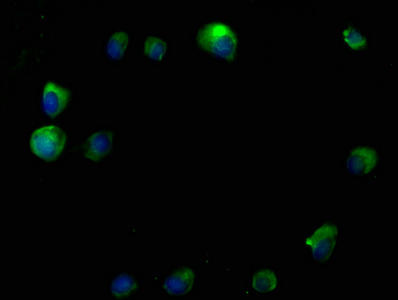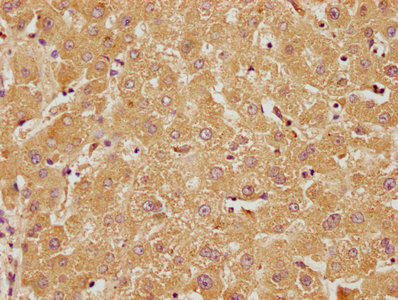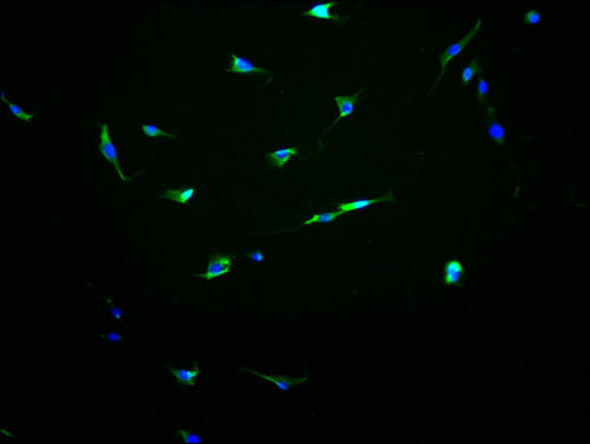Description
| Antibody Name: | RTN4RL2 Antibody (PACO62059) |
| Antibody SKU: | PACO62059 |
| Size: | 50ul |
| Host Species: | Rabbit |
| Tested Applications: | ELISA, WB, IHC, IF |
| Recommended Dilutions: | ELISA:1:2000-1:10000, WB:1:1000-1:5000, IHC:1:20-1:200, IF:1:50-1:200 |
| Species Reactivity: | Human |
| Immunogen: | Peptide sequence from Human Reticulon-4 receptor-like 2 protein (355-372AA) |
| Form: | Liquid |
| Storage Buffer: | Preservative: 0.03% Proclin 300 Constituents: 50% Glycerol, 0.01M PBS, pH 7.4 |
| Purification Method: | Antigen Affinity Purified |
| Clonality: | Polyclonal |
| Isotype: | IgG |
| Conjugate: | Non-conjugated |
 | Western Blot. Positive WB detected in: K562 whole cell lysate, SH-SY5Y whole cell lysate, Hela whole cell lysate, HL-60 whole cell lysate. All lanes: RTN4RL2 antibody at 1:2000. Secondary. Goat polyclonal to rabbit IgG at 1/50000 dilution. Predicted band size: 47, 22 kDa. Observed band size: 47 kDa. |
 | Immunofluorescence staining of MCF-7 cells with PACO62059 at 1:50, counter-stained with DAPI. The cells were fixed in 4% formaldehyde, permeabilized using 0.2% Triton X-100 and blocked in 10% normal Goat Serum. The cells were then incubated with the antibody overnight at 4°C. The secondary antibody was Alexa Fluor 488-congugated AffiniPure Goat Anti-Rabbit IgG(H+L). |
 | IHC image of PACO62059 diluted at 1:100 and staining in paraffin-embedded human liver tissue performed on a Leica BondTM system. After dewaxing and hydration, antigen retrieval was mediated by high pressure in a citrate buffer (pH 6.0). Section was blocked with 10% normal goat serum 30min at RT. Then primary antibody (1% BSA) was incubated at 4°C overnight. The primary is detected by a biotinylated secondary antibody and visualized using an HRP conjugated SP system. |
| Background: | Cell surface receptor that plays a functionally redundant role in the inhibition of neurite outgrowth mediated by MAG (By similarity). Plays a functionally redundant role in postnatal brain development. Contributes to normal axon migration across the brain midline and normal formation of the corpus callosum. Does not seem to play a significant role in regulating axon regeneration in the adult central nervous system. Protects motoneurons against apoptosis; protection against apoptosis is probably mediated by MAG (By similarity). Like other family members, plays a role in restricting the number dendritic spines and the number of synapses that are formed during brain development. Signaling mediates activation of Rho and downstream reorganization of the actin cytoskeleton. |
| Synonyms: | Reticulon-4 receptor-like 2 (Nogo receptor-like 3) (Nogo-66 receptor homolog 1) (Nogo-66 receptor-related protein 2) (NgR2), RTN4RL2, NGRH1 NGRL3 |
| UniProt Protein Function: | RTN4RL2: May play a role in regulating axonal regeneration and plasticity in the adult central nervous system. Belongs to the Nogo receptor family.Protein type: Membrane protein, GPI anchor; Cell development/differentiation; Receptor, misc.Chromosomal Location of Human Ortholog: 11q12.1Cellular Component: anchored to plasma membrane; cell surface; cytoplasmMolecular Function: protein kinase inhibitor activity; receptor activityBiological Process: axon regeneration; cytokine and chemokine mediated signaling pathway; negative regulation of JAK-STAT cascade; negative regulation of protein kinase activity |
| UniProt Protein Details: | |
| NCBI Summary: | |
| UniProt Code: | Q86UN3 |
| NCBI GenInfo Identifier: | 74759401 |
| NCBI Gene ID: | 349667 |
| NCBI Accession: | Q86UN3.1 |
| UniProt Secondary Accession: | Q86UN3,Q0GGW3, Q17RL9, Q6X813 |
| UniProt Related Accession: | Q86UN3 |
| Molecular Weight: | 21,373 Da |
| NCBI Full Name: | Reticulon-4 receptor-like 2 |
| NCBI Synonym Full Names: | reticulon 4 receptor-like 2 |
| NCBI Official Symbol: | RTN4RL2 |
| NCBI Official Synonym Symbols: | NgR2; NGRH1 |
| NCBI Protein Information: | reticulon-4 receptor-like 2 |
| UniProt Protein Name: | Reticulon-4 receptor-like 2 |
| UniProt Synonym Protein Names: | Nogo receptor-like 3; Nogo-66 receptor homolog 1; Nogo-66 receptor-related protein 2; NgR2 |
| Protein Family: | |
| UniProt Gene Name: | RTN4RL2 |
| UniProt Entry Name: | R4RL2_HUMAN |






